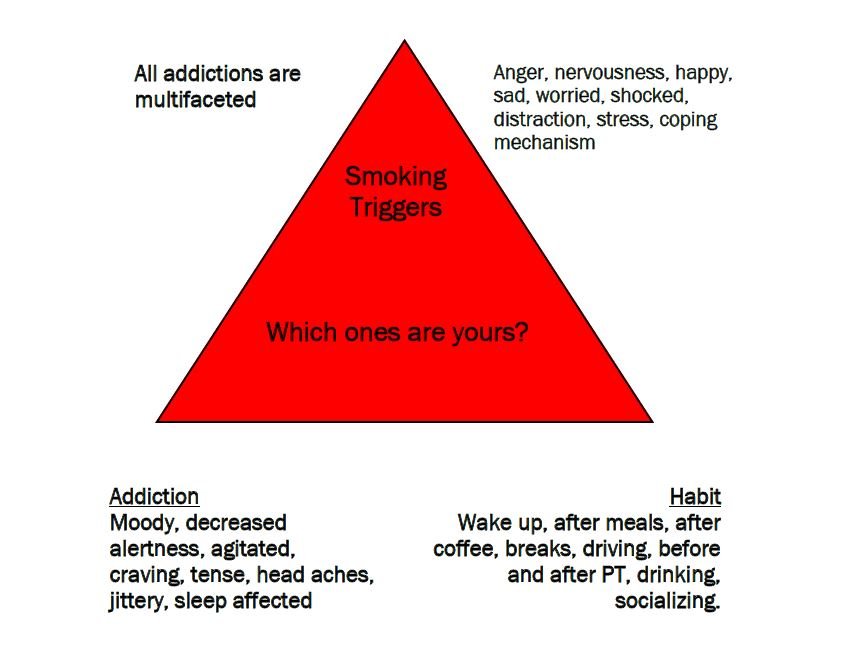Courtesy of the Stuttgart Health Clinic
For assistance to quit smoking now, contact DSN:590-2900/civ. 06371-9464-2900.
Download the information pdf click here.

The consequences of using tobacco
On your health:
Circulatory System
Blood Vessels Narrow = poor circulation
Eye health is affected by poor circulation
The skin is affected by poor circulation
Legs & arms are affected by poor circulation
Domino effect
Side effects of tobacco use:
High Blood Pressure
Coronary Heart disease
Hardening of arteries
Teeth stains
Gum Disease
Cancer (lung, throat, mouth, pancreas, etc.)

When you use tobacco you increase your risk of:
Stroke
Heart Attack
Cancer
The Hard Facts
- 1/2 of all smokers that don’t quit die from tobacco related illness.
- Tobacco is as addictive as heroin.
Your Habit affects others:
Family
Tension between you and your spouse or partner
Health consequences for those that live with you due to second hand smoke
Children
Respiratory issues
Asthma
Auto Immune Deficiency
Ear Aches
Decreased performance in school
Friends & Coworkers
Health consequences due to second hand smoke
Tension due to different opinions regarding tobacco use
Did you know, many employers in the civilian world won’t hire smokers due to insurance costs and lost work time.
Tobacco and Men vs. Women
Your body is like an airplane with four engines. The plane can still run even if one, two, or even three of the engines are down. But you better hope that last engine doesn’t quit or the plane will come crashing out of the sky.
- Women metabolize nicotine differently than men so that nicotine actually stays in the system longer.
- Smoking while pregnant can have serious health implications for your unborn child.
- Lung cancer causes more deaths in women than breast cancer.
- More than 173,000 women die from smoking related diseases each year.
Patterns of Psychological Dependence
Everyone’s pattern of dependence is different. The important thing is that you start thinking about what triggers your tobacco usage.
It’s not how fast you stop using tobacco, but for how long. It’s not a sprint, it’s a marathon.

E-cigarettes, chewing tobacco, cigars and cigarettes… are all deadly!
Fast Facts
- One can of dip can amounts to the nicotine of roughly 400 cigarettes of nicotine.
- E-cigarettes are not currently regulated and contain synthetic nicotine as well as at least 10 cancer causing substances.
- Vapor and smoke are both bad!
- Nicotine binds to red blood cells.
- Smoking a pack a day is like carrying 100 extra lbs. in terms of your health. That’s 5 extra lbs. per cigarette!
- Don’t let clever advertising fool you, tobacco in any form is bad for your health. Refuse to let tobacco companies profit from destroying your health!
Get the tools to quit
- Identify what triggers your habit
- Find the best strategy for you (medical vs. nonmedical)
- Prepare yourself to combat your cravings
- Understand the “hand-oral reflex”
- Focus on positive outcomes
- Stay motivated: you can do it!
What is the “hand-oral” reflex?
The natural tendency for human beings to want to put something in our hands in our mouths. Smoking cigarettes satisfies this tendency, but there are healthier alternatives that won’t even cause you to gain weight:
- Licorice

- Carrot Sticks
- Grapes
- Sunflower seeds
- Apples
- Pretzels
- Beef Jerky
- Peppermints
Other tools to combat your craving:
- Chewing gum
- Medical treatment
- Drink plenty of H20
What to expect when you quit using tobacco:
WITHIN 20 MINUTES OF YOUR LAST CIGARETTE OR LAST DIP/CHEW
- You stop polluting the air
- Blood pressure drops to normal
- Pulse drops to normal rate
- Temperature of hands and feet increases to normal
8 HOURS
- Carbon monoxide level in blood drops to normal
- Oxygen level in blood increases to normal
24 HOURS
- Chance of heart attack decreases
48 HOURS
- Nerve endings adjust to the absence of nicotine
- Ability to small and taste enhanced
72 HOURS
- Bronchial tubes relax, making breathing easier
- Lung capacity increases
2 WEEKS TO 3 MONTHS
- Smokeless tobacco lesions in the mouth are healed
- Circulation improves
- Walking becomes easier
- Lung function increases up to 30%
1 TO 9 MONTHS
- Coughing, sinus congestion, fatigue, and shortness of breath all decrease
- Cilia regrow in lungs increasing ability to handle mucus, clean the lungs and reduce infection
- Body’s overall energy level increases
1 YEAR
- Heart disease death rate is halfway back to that of a nonsmoker
5 YEARS
- Heart disease death rate drops to the rate for non smokes
- Lung cancer death rate decreases halfway back to that of nonsmokers
10 YEARS
- Lung cancer death rate drops almost to the rate of nonsmokers
- Precancerous cells are replaced
- The incidence of other cancers—of the mouth, larynx, esophagus, bladder, kidney, and pancreas decreases
Source: American Cancer Society Virginia Division, Inc.
What happens when you quit smoking?
Within 48 hours your nerves start to regenerate
Everything tastes better (wine, spices, salt)
Your clothes and breath smell better
You will have more energy
Financial Savings
Increased circulation
Increased red blood cell count
Increased lung capacity (you can run better!)
Reduced risk for developing health problems associated with tobacco use
Better quality of life!
You can gain back years lost off your life due to tobacco. When you smoke:
- Men lose 13.2 years off their lifetime.
- Women lose 14.5 years off their lifetime.
Resources for nonmedical treatment options, and where to find them:
TriCare Prime and Plus Beneficiaries– Visit your health care team at Stuttgart health clinic
TriCare Standard and Non-TriCare Beneficiary – You can be seen at Stuttgart health clinic on space available basis
Visit the Wellness Center to sign up for Meta-bolic and body fat composition testing
Contact Stuttgart health clinic to schedule an appointment with a Certified Dietician for a personal nutrition consultation Medical Treatment Options
Make an appointment with your primary care doctor to find out about your options for pharmaceutical treatment (nicotine patches, nicotine gum, Bupropion, Chantix)
Consult with your primary doctor for other methods to help you with quite smoking
Hypnosis
Acupuncture
Magnet Therapy
Filters
Mind-Body Practices
Helpful Links
www.ucanquit2.org
http://smokefree.gov
http://www.cancer.org
http://www.lung.org
http://www.heart.org
Phone numbers to help you quit:
For assistance to quit smoking now, contact the Stuttgart Health Clinic at DSN:590-2900/civ. 06371-9464-2900.
CDC Free Support Line: 1-800-QUIT-NOW
Nicotine Anonymous (NicA): 1800-TRY-NICA
QuitNet: 1877-44U-QUIT
American Heart Association: 1800-AHA-USA-1
American Lung Association: 1800-548-8252
